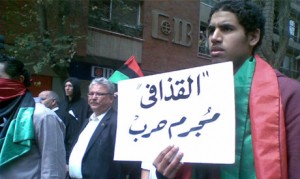 Deadly strikes on rebel fighters sparked confusion and outrage outside this port city Thursday, with rebels at first accusing NATO warplanes of targeting them, and a rebel spokeswoman later saying the attack came from forces loyal to Libyan leader Moammar Gaddafi.
Deadly strikes on rebel fighters sparked confusion and outrage outside this port city Thursday, with rebels at first accusing NATO warplanes of targeting them, and a rebel spokeswoman later saying the attack came from forces loyal to Libyan leader Moammar Gaddafi.
If the spokeswoman is right, the assault — which doctors said killed at least two fighters — would be the first by Libyan warplanes since the United States and NATO began enforcing a no-fly zone in Libya three weeks ago.
Rebel fighters said they have grown so accustomed to the Western alliance controlling the skies that, when the low-flying planes fired upon several tanks and a passenger bus, they assumed the planes belonged to NATO.
Hours later, however, a rebel spokeswoman in Benghazi said the strikes — on the road between Ajdabiya and Brega — probably came from Gaddafi.
Rebel forces, meanwhile, came under fire from government loyalists at Ajdabiya’s western gate and rapidly retreated. Many fighters, and some of the few families who had not yet fled the town after weeks of fighting, drove north and east toward Benghazi, the rebel capital, their pickup trucks and cars filled with everything from mattresses to suitcases to automatic weapons.
The main hospital in Ajdabiya was evacuated, with its patients and staff also headed to Benghazi.
But the Gaddafi forces appeared not to have entered the city proper, and at least some rebel fighters remained.
Meanwhile, the U.S. general who led the first stages of the military intervention by the U.S. and NATO told a Senate committee is Washington that a stalemate is emerging in Libya.
U.S. Gen. Carter Ham said he agreed when Sen. John McCain (R-Ariz.) asked, “Would you say that the situation on the ground is a stalemate or an emerging stalemate?” Ham also responded to a question from McCain that a stalemate seemed “more likely” now that command of the action has been turned over to NATO.
The Gaddafi forces’ airstrikes early Thursday targeted rebel tanks and a passenger bus loaded with rebel fighters, who said they had been sent to the area Wednesday night by the Benghazi-based rebel command.
Doctors at one hospital in Ajdabiya said between two and seven rebel fighters were killed, and several others were injured.
The fighters immediately blamed the airstrikes on NATO, calling it a repeat of an incident last Friday in which NATO bombs mistakenly killed 13 rebels and injured seven others. That incident was triggered when the rebels fired their weapons into the air in celebration — an act that NATO forces mistook for hostile fire.
“The last time it was a mistake. But today, they knew it was us, and they shot us,” said Mohammed Ahmed, a doctor at the hospital.
The outraged rebels said their commanders informed NATO of their plans to deploy about 12 miles outside Brega. Their tanks and bus were parked, and marked with the green, black and red rebel flag.
Nevertheless, according to the fighters, low-flying planes fired on the tanks and bus, then flew away, returned and attacked again.
“They shot at us,” said 25-year-old Ahmed Saleh Yousef, weeping outside the hospital in Ajdabiya. “I thought I was going to die.”
Yousef said five friends who had fought with him for weeks on the front lines of Libya’s civil revolt had been killed in the strikes.
Yousef said that after the airstrikes, pro-government forces also began firing rockets at the rebels.
NATO said it was investigating the initial rebel version of what happened, but it did not reveal whether coalition warplanes were in the area outside Brega at the time of the strikes. The alliance said fighting in the area has been “fierce” for several days, and the battlefield remains confused and disorganized.
“The situation is unclear and fluid, with mechanized weapons traveling in all directions,” said a statement from NATO facilities in Naples.
Tensions between NATO and the rebel fighters have been growing, as rebels have complained that the alliance is easing off its attacks on Gaddafi’s military resources.
U.S. and European leaders say Gaddafi loyalists are hiding their tanks and artillery in densely populated areas, which the alliance cannot easily reach without risking significant civilian casualties.
Immediately after the airstrikes, before the rebel spokeswoman said the planes were apparently Gaddafi’s, a NATO official in Brussels said the alliance was looking into the allegations that NATO had orchestrated the strikes. WP

Leave a Reply
You must be logged in to post a comment.